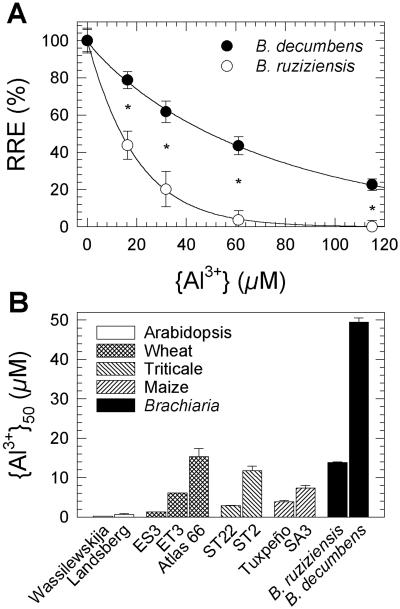Figure 1.
Al resistance of signalgrass (B. decumbens) and ruzigrass (B. ruziziensis), quantified with a root elongation assay in simple salt solutions. A, Relative root elongation (RRE; see Eq. 1 in “Materials and Methods”) of 4-d-old seedlings exposed to 200 μm CaCl2 (pH 4.2), containing 0 to 200 μm AlCl3, for 3 d (means ± se of 27–36 seedlings). RE0 was 40.8 mm (signalgrass) and 39.8 mm (ruzigrass). RE∞ was 9.8 mm for ruzigrass, but could not be measured for signalgrass because this would have required Al levels predicted to cause precipitation of Al(OH)3. RE∞ of signalgrass was thus estimated, assuming a constant RE0/RE∞ ratio for both species (10.0 mm). RRE values as a function of the Al3+ activity in the treatment solution were fitted to Equation 2 (solid lines). Asterisks denote statistically significant interspecific differences (P < 0.05). B, Comparison of Al resistance of Brachiaria spp. with contrasting genotypes of other species. RRE data were taken from the literature to determine {Al3+}50, the Al3+ activity causing a 50% inhibition in root elongation (Eqs. 3 and 4). Assay conditions for these genotypes were as follows: Arabidopsis, 0 to 2.5 μm AlCl3, 100 μm CaCl2 (pH 5.2) for 5 d (Toda et al., 1999); wheat, 0 to 10 μm AlCl3, 200 μm CaCl2 (pH 4.3) for 7 d (ES3 and ET3; Ryan et al., 1995b) or 0 to 150 μm AlCl3, 400 μm CaCl2 (pH 4.5) for 2 d (Atlas 66; Kinraide et al., 1992); triticale, 0 to 50 μm AlCl3, 500 μm CaCl2 (pH 4.5) for 1 d (Ma et al., 2000); and maize, 0 to 142 μm AlCl3, approximately 230 μm CaCl2 (pH 4.3) for 3 d (Pellet, 1993).

